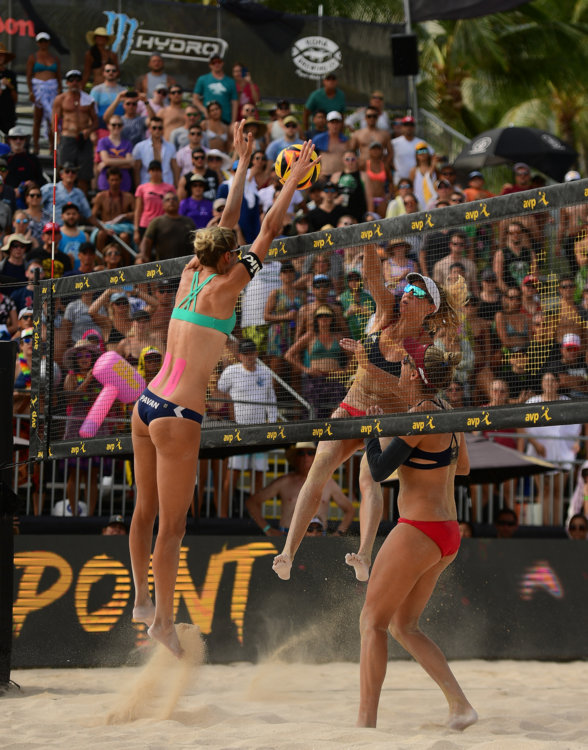Beach volleyball seems simple enough. I mean, it’s basically an adult version of “Keep the Balloon off the Floor,” a game my siblings and I loved and broke a few lamps playing. But the game is anything but simple. Two people intend to cover 900 ft2 of sand and prevent gravity from applying. Spoiler alert—gravity wins. The ball always hits the ground.
To make matters worse, humans are just getting bigger and stronger. The AVP tour is so tall and strong and athletic, and everyone can still finesse all over the court. Serves can hit the sand within seconds of leaving the server’s hands; spikes can break (and have broken my) fingers. Matches are only canceled in lightning, so we’ve all trudged through densely soaked sand, swirling winds, and pelting rain trying to accumulate 21 points twice in a row. There are five block calls, hard hits, offspeed shots, varying serving methods, and endless styles of play.
Factoring in all of these variables is the brain of the game; it’s what makes it (in my totally unbiased, third-party opinion) the smartest sport ever created. The science is what holds people to this game forever; it creates volley nerds and is why players continue competing well into their forties. There’s always more to learn, new ways to grow. The game is ever-evolving, challenging us in ways we can’t find anywhere else. We can’t get enough. It’s a drug.
So you shouldn’t be surprised to hear that most volleyball players are intelligent. At least, the ones I know are.
And few are smarter than Sarah Pavan.
While pursuing her second Olympics appearance, she’s also earning a Master’s degree, is a talented classical musician, and led our Geeks who Drink trivia team to victory. Twice. (We’ve only ever come close to winning when Sarah’s been there.)
Sarah’s intellect is equally as impressive as her athleticism. So, naturally, when I set out to write an article on approaching the game cerebrally, I thought of her. I asked Sarah to write about anything from playing the wind to scouting a team to anything else that goes into the brain aspect of the game. She took a few days and crafted one of the best submissions I’ve had the pleasure to edit. In true Sarah style, her thoughts were complete, thoughtful, well-communicated, and carefully chosen.
So I’m sharing them, unaltered, with you. Enjoy.

SP:
When we are preparing to play a team, the first thing I do is watch video of some of their most recent matches. I am looking for cues that will help our team defensively; specifically, passing angles, attack types and locations, and any physical tells that happen when the players are executing certain shots.
Players often have a couple of passing angles that put them into trouble. Looking at this is important because it helps our team prioritize where to serve from and to which part of the passer’s body or surrounding area to target. Physical cues are just as important as serving angles, though, and often trump serve location or attack type tendencies. We are looking for things like an elbow drop, a shoulder twist, or approach angle that consistently lead to a cut shot, an angle swing, etc. We also look for sequence patterns. I watch all of these things from a blocker’s perspective to make the correct reads and calls at the net, and Mel watches from a defender’s perspective to help her knock off attack options and get a jump on balls in the backcourt.
When we watch these things, we aren’t expecting them to work 100% or even 50% of the time. We have to play in the moment and be athletes, but we are picking up on little clues that we are able to exploit when it really matters—right before a side switch, right before the technical timeout, or if the match is tied at 20-20. If we can steal just 2 points based on what we learned by studying our opponent, then we feel like we were productive in our video analysis.

After watching video on how to properly attack the team from the service line and how to defend against them, we watch film of our previous matches against them. This helps us see how the team last served us, which angles they chose to exploit, and what their defensive strategy was. Understanding this helps us prepare our serve receive priorities. It also makes us reflect on our own tendencies and why the team attempted certain defensive strategies against us.
We go to the match with a very specific plan and are always fully prepared to execute it, but sometimes Mother Nature has different plans. If the conditions are particularly windy or humid, we may decide to prioritize those factors instead. In these situations, we always remember our plan for each player, but we use the elements to our advantage. We’ll serve directly into the wind or use more short and deep serves in the humidity to tire opponents out.
At the end of the day, no matter how much we prepare, we need to take care of our side of the net first. If we are playing sloppy and are not doing the basics right on our side, even the most perfect game plan will be useless.
There is a lot more to beach volleyball than meets the eye, and figuring out the chess game is probably my favorite part of the sport.
——
Mine too, Sarah.